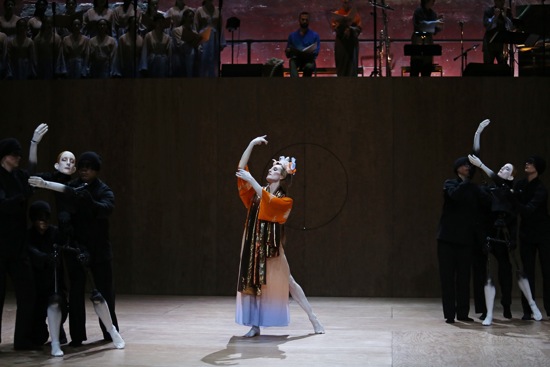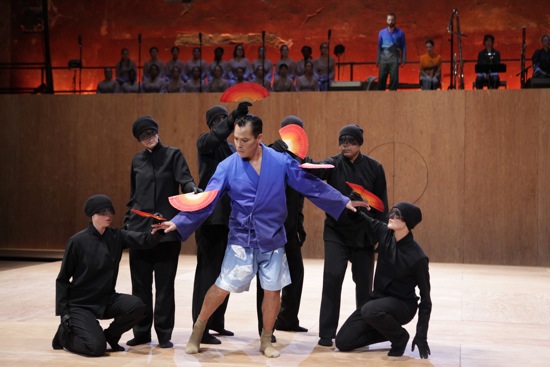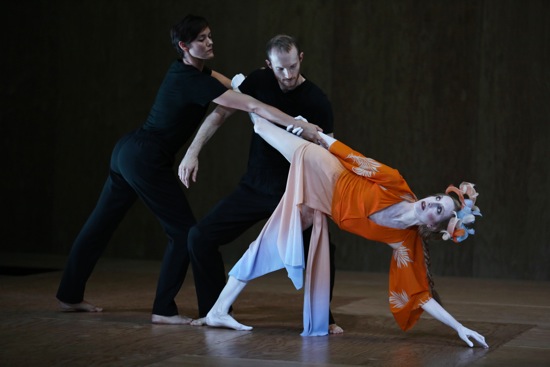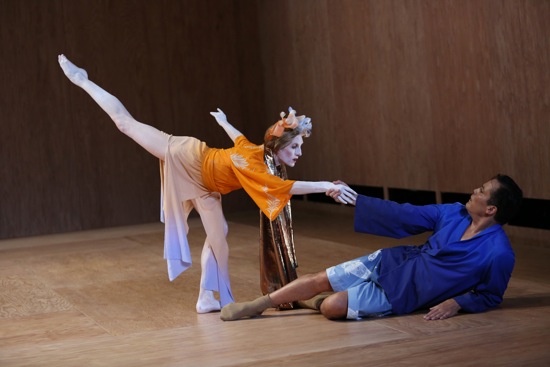Wendy Whelan and Jock Soto dance together again in a new approach to a Noh play.
It is a marvelous robe! Well, not a robe exactly; it looks more like a shawl—light as feather, shimmering with gold, unearthly. It gives its name to a Japanese legend and to Hagoromo, the 16th-century Noh drama it inspired; the robe belongs to a celestial dancer who can depict through her movements the changes in the moon. Why did she take it off? Did she wish to bathe in the bay at Miwo? This is just one of the enigmas in the play and in the transmutation of the story into a dance- opera presented by the Brooklyn Academy of Music and America Opera Projects.
David Michalek, who conceived and directed Hagoromo; David Neumann, who choreographed it; Nathan Davis, who wrote the music; and Wendy Whelan and Jock Soto (long-time partners in New York City Ballet), who play the two characters in the story—these and numerous others have together created moments of considerable beauty and imagination. The five musicians of the International Contemporary Ensemble sit on a high platform at the back (set design by Sara Brown); from there, sing Peter Tantsits (tenor) and Katalin Károlyi (contralto), and there the women members of the superb Brookyn Youth Chorus are ranged in two rows. Clifton Taylor’s lighting turns the BAM Harvey’s brick wall behind the musicians a glowing red. Set into the wooden wall that seems to support all this are two semicircular doors that open to reveal a giant moon.
The story is a simple one. A fisherman, swept by a storm onto a nearby island, finds the “feather robe” hanging on a tree and thinks he might display it in his house and charge money to see it. The celestial dancer (called an angel in this production) asks him to give it back to her; he refuses, but relents as he sees her begin to weaken and die when bereft of the power it gives her. A deal is struck; he will give back the robe if she will dance and teach him a part of her dance (which will do wonders for his health).
To enrich the tale Michalek has added puppets. Animals playing near the robe accidentally untether it and it flies away. A big furry cat whose tail seems to grow out of its neck is manipulated by two of the production’s six puppeteers (one of them kneeling on a wheeled platform that the other pushes around). The other animal is a rambunctious, much smaller white dog. That it looks as if it had been folded into existence by a master of origami only adds to its yappy charm (rather than turn it around, its handler simply removes its head and replaces it at the other end).

Hagoromo: Wendy Whelan in her celestial dance flanked by her puppet images.
Photo Credit: Julieta Cervantes
Two life-sized puppets also figure importantly. They have pale faces and bald heads, and their legs above the knee are simply metal framework. Chris M. Green is credited with puppetry. Three puppeteers work each doll (the puppeteers: Len Carillo, Pepper Fajans, Catherine Gowl, Leah Hofmann, Rowan Magee, and Erin Orr). These creatures can imitate Whelan’s gestures and steps. I kept wondering who these twin guys were, but my perceptiveness must have been taking a break, because I later realized that they were extensions of Whelan, and their faces were modeled on hers. I’m not convinced she needed these doppelgangers to enhance her aura, which is considerable.
The puppeteers are, however, wonderfully effective. They support Whelan in flight (puppet of the gods?) and manipulate her as if she too needed guidance. They band together into a living storm to pull and push Soto in all directions. In one lovely moment, they cluster around him, fluttering fans to suggest the flock of twittering birds that the musical score provided. Nor do those in the chorus only sing. They too wield fans at key moments, or clap their hands. In the inspired ending, when the fisherman is left alone onstage and in silence, they rapidly flick their fans, and the sound is that of wings, as the celestial dancer returns to her home in he heavens.

Jock Soto surrounded by “birds.” At back on the platform, singers Peter Tantsits (standing) and Katalin Károlyi (seated), the Brooklyn Youth Chorus, and musicians.
Photo: Julieta Cervantes
The movement style has been derived from Noh. The two dancers travel in ceremonious walks (tiny shuffling steps). Whelan, however, enters as smoothly as quiet water, extending one long leg and beautifully arched foot in a way that recalls Balanchine’s wish that a dancer should make her legs as flexible as an elephant’s trunk. She and Soto move, most of the time, with extreme slowness, pausing to emphasize the positions at which they arrive. Neumann’s choreography avoids balleticism most of the time (there a few sights more touching than that of Whelan slowly walking backward along the rim of the shining “water” that separates the stage from the audience; her bare toes, almost prehensile, feel out that narrow division between sea and shore).
Her costume for Part 2 (by Dries Van Noten) makes her look even more ethereal than she usually does, and when Soto lifts her, she seems weightless, as if flying above him without his aid. It’s also interesting to see Soto’s wielding of the piece of desirable fabric; he’s almost sensual, quickened by it. Once he crawls along holding it in his teeth.
Davis’s music is impressive—drawing on the sparse clarity of traditional Japanese music, but also implementing its occasional clamor in very contemporary ways. I cannot name the large unfamiliar instruments that the flautist (Claire Chase) and the bassoonist (Rebekah Heller) also play, their bodies responding to the effort. Tantsits and Károlyi use their fine voices to great effect, with Tantsits also wielding a fat rope with a knot in it to lash a drum at his feet. The words of the libretto—a new version of the play’s text by Brendan Pelsue— are both sung and projected on surfaces above and beside the stage. This becomes problematic, since Károlyi, for whom English is a second language, doesn’t always make every word clear, and glancing from the projected titles to the action below is distracting; even though the text (which can be read online in Ezra Pound’s translation) has been pared down considerably, you can’t always experience the poetry of the words as clinging to the action.
For me, two aspects of Hagoromo weigh heavily against its beauties. One is difficult to articulate. Despite the remarkable intensity of the performers, the action onstage too often lags or goes temporarily dead. This is not a factor of its slowness (a Noh play can hypnotize you), but something that needs directorial tightening.
The other disappointment is the absence of what is in a Noh play the climactic moment: the dance in which the main actor reveals his character’s history and intentions. Here is what the celestial dancer says to the fisherman in Pound’s translation: “Learn then this dance that can turn the palace of the moon. . . .For the sorrows of the world, I will leave this new dancing for you for sorrowful people. But give me my mantle for I cannot rightly perform the dance without it.”
I expected Whelan to perform this celestial dance for Soto and teach him some of its movements. She does dance, and Soto follows her with tender attentiveness. But the way the puppet versions of her are introduced diminishes rather than enhances this climatic moment. And how this great stewardess of the moon’s phases might, like a Noh actor, convey her essence in a solo dance never lights up the stage. If anyone could project that incandescent power, it would be Whelan.



Tasty and nuanced as ever, thank you for sharing your perceptions of Hagoromo. I am enchanted by the awareness of Wendy and Jock collaborating with Neumann and the others on this project in their post-NYCB chapters.
You captured both the rapture and problems with the work. The spareness of the design and structure may have led to an underutilizing of the artistry and potential of the dancers. Where was the choreographer?
Beautiful writing and I couldn’t help thinking about Noguchi’s designs for Cave of the Heart, some of which were inspired by I think a different Noh drama. I particularly loved the description of the “cat” and “dog”; animals are very difficult to represent on stage in any convincing way, Puss in Boots in Sleeping Beauty notwithstanding!